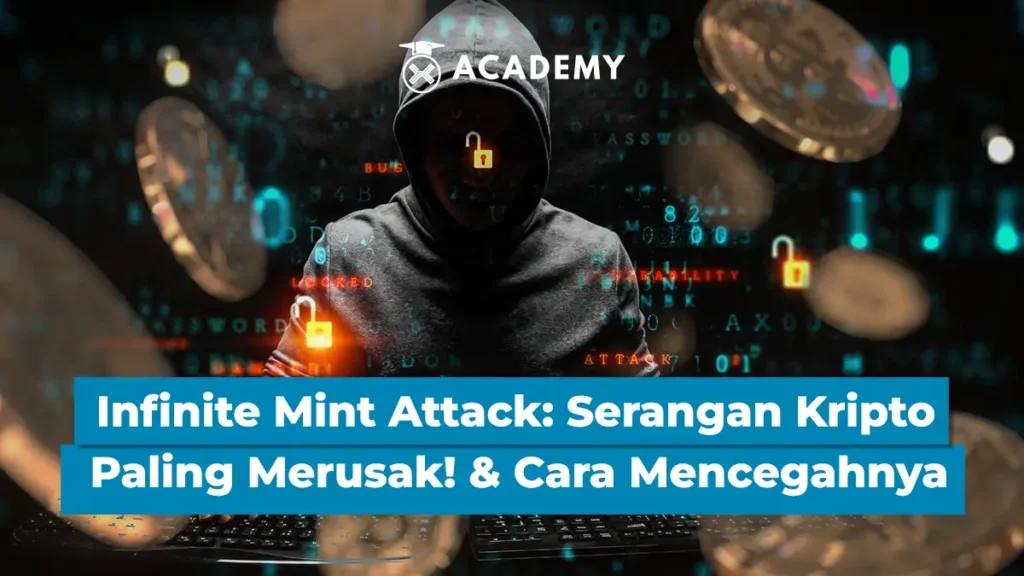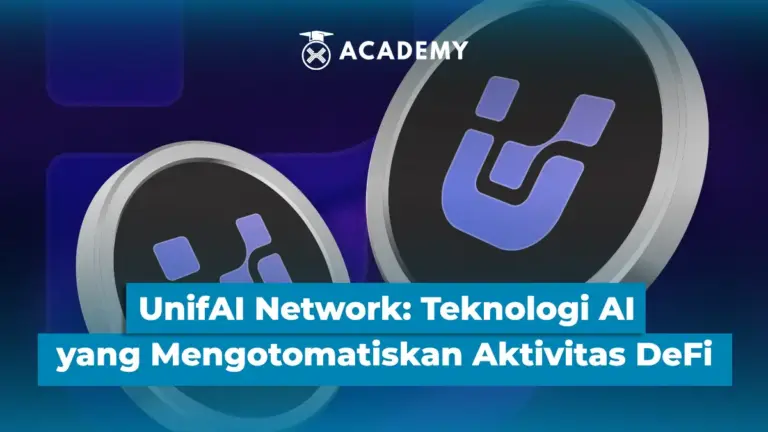Imagine if someone could mint billions of tokens from a crypto project in just a few seconds, without limits and without authorization.
Tokens that should be valuable because of their scarcity suddenly flood the market, their value immediately drops, and liquidity disappears instantly. This is known as an Infinite Mint Attack.
This type of attack is not just a technical error. It is a critical vulnerability in a smart contract that can destroy the DeFi ecosystem overnight.
If you are interested in the world of digital assets and want to understand more about how this attack mechanism works, let’s explore further!
Also read related articles: Tornado Cash: A Controversial Crypto Privacy Tool
What is an Infinite Mint Attack

Infinite Mint Attack is a type of attack carried out by hackers by exploiting loopholes in smart contracts.
Through this exploit, they can mint tokens in very large quantities, exceeding the supply limit that should be set by the protocol.
When this attack is successful, the token supply swells extremely and immediately destroys the market value of the token.
The perpetrators will usually sell all the fake minted tokens to the market, causing the price to plummet and harming many parties.
This attack often occurs due to security holes in the smart contract code, such as logical errors in the minting function or lack of access control restrictions.
In many cases, attackers can immediately drain liquidity and make huge profits in just minutes.
One real-world example of this attack occurred on Cover Protocol, where hackers managed to mint up to 40 quintillion (40,000,000,000,000,000,000,000) COVER tokens due to a bug in the shield mining contract.
The attack caused the token value to plummet by 97% and around $4,400,000 in assets were drained from the project.
In 2021, PAID Network was attacked after someone stole private keys and modified their smart contract code.
The attacker managed to mint over 59,000,000 $PAID tokens and converted most of them into ETH. As a result, the project suffered massive losses and the token price dropped by over 80%.
Because this attack is so damaging and difficult to recover from, the Infinite Mint Attack is considered one of the most dangerous threats in the DeFi ecosystem.
Therefore, code audits and implementing a multi-layered security system are very important in the development of blockchain-based projects.
How Infinite Mint Attacks Work
These attacks occur when hackers exploit a weakness in a smart contract, usually the mint function, by exploiting a logic error or weak access control.
This vulnerability allows unauthorized minting of large amounts of tokens, which are then sold on the market before being detected, causing the token value to plummet.
General Scheme
1.Attackers find a vulnerability in the mint function
The first step in this attack is the process of identifying weaknesses in the smart contract code, specifically in the mint function that regulates token minting.
Hackers will analyze the logic and structure of the contract to find weak points, such as unvalidated inputs or parameters that can be manipulated.
2.They trigger a large minting of tokens
After finding a vulnerability, the attackers construct a transaction that exploits the bug. This transaction will trigger the automatic minting of tokens in very large quantities, even reaching billions of tokens in a matter of seconds.
3.Fake tokens are sent to their wallets
The successfully minted tokens are then immediately sent to the perpetrator’s digital wallet. Since this process occurs inside a smart contract, the system does not automatically distinguish whether the token is legitimate or an exploit.
4.The token is immediately sold on the market before being detected
Before the project developer or community realizes the attack has occurred, the attacker quickly sells the fake tokens on the open market.
This massive sale causes the token price to drop drastically, while the attacker has already converted it into other crypto assets such as stablecoins.
Common Causes
1.Mint function is not restricted by access rights
One common mistake in smart contracts is that there are no restrictions on who can use the mint function.
If this function is publicly accessible without restrictions, hackers can easily use it to mint tokens without permission.
2.No validation of minting conditions
Smart contracts that do not verify the terms or conditions before minting tokens are highly vulnerable to exploitation.
For example, there is no check whether the number of tokens requested has exceeded the maximum limit, or whether the minting is actually authorized by the system.
3.Smart contracts are not properly audited
Many crypto projects launch smart contracts without thorough security audits. Without a rigorous third-party audit process, critical bugs can go unnoticed and become a gateway for attacks like the Infinite Mint Attack.
You might also like: Beware, Replay Attack: An Old Cyber ??Threat That Is Still Deadly!
Fatal Impact of Infinite Mint Attack
Infinite Mint Attack can destroy a crypto project in a matter of minutes.
Once the vulnerability is successfully exploited and tokens are minted in unreasonable amounts, the impact spreads very quickly throughout the ecosystem, from the market to the supporting community.
Main Impacts
1. Token prices drop drastically to zero
When fake tokens flood the market, the law of supply and demand immediately kicks in. The surge in supply causes prices to plummet drastically, even in some cases dropping their value to zero.
2. Liquidity is lost from the pool
The perpetrators usually exchange the exploited tokens into other assets in the liquidity pool, draining the existing funds. This makes it difficult for legitimate users to exchange their tokens because the pool is empty.
3. Community trust collapses
In the crypto world that relies heavily on the community, the loss of a sense of security and trust can be a major blow. Users begin to doubt the security of the project and are reluctant to participate again.
4. The project is considered a failure or scam
After the attack, the project’s reputation is destroyed. Many immediately label it as a scam even though it is actually only due to a technical flaw. This can cause the project to be abandoned completely and lose the opportunity to rise again.
Real Case Examples of Infinite Mint Attacks
To understand how dangerous the Infinite Mint Attack is, let’s look at some real incidents that have rocked the crypto world.
These cases show how a small flaw in a smart contract can lead to millions of dollars in losses and the collapse of trust in a project. Here are some of them:
1. Cover Protocol (2020)
One of the most famous incidents in DeFi history occurred in 2020, when the Cover Protocol project experienced a severe Infinite Mint Attack.
This attack exploited a flaw in Cover’s smart contract, specifically in the Blacksmith contract, which is related to the staking reward system.
The perpetrators managed to manipulate the deposit and withdrawal functions to exploit the invalid accRewardsPerToken value.
As a result, they were able to mint up to 40,000,000,000,000,000,000,000 COVER tokens, creating an absolutely ridiculous token supply.
From this exploit, the hackers minted over $37,000,000 worth of tokens and immediately sold them on various decentralized exchanges.
The impact was devastating, with the price of COVER tokens plummeting by 97%, the user community panicking, and trust in the project being completely destroyed.
Although this vulnerability was eventually patched by security firm PeckShield, Cover Protocol’s reputation had already collapsed. Shortly after, the project decided to merge with Yearn Finance as a recovery measure.
2. Meerkat Finance (2021)
Another case occurred on the Binance Smart Chain (BSC) network in 2021, when the Meerkat Finance project experienced an illegal minting attack shortly after its launch.
In this incident, the perpetrators managed to exploit the mint function in the Meerkat contract, allowing them to mint large amounts of tokens and immediately steal funds from the protocol.
The recorded losses in this attack amounted to around $31,000,000, making it one of the largest thefts in the early days of BSC.
This incident led to speculation that the attack was an act of rug pull or internal fraud,, considering that the project had only been active for a day before the funds were lost.
To this day, the Meerkat Finance case remains a reminder of the importance of auditing and transparency from the very beginning of a DeFi project.
Other interesting articles for you: Crypto Security: 5 Practical Steps to Avoid Hacking
How to Prevent Infinite Mint Attack

For crypto project developers, security is not an option, it is a necessity. The Infinite Mint Attack could destroy a project’s reputation and value in an instant.
Therefore, prevention needs to be done from the earliest stages of development, with a comprehensive approach that puts security as the top priority.
Every aspect from smart contracts to public communications should be designed to anticipate and respond to potential exploits.
Preventative Measures:
1. Audit smart contracts by a third party such as Certik or PeckShield
A thorough audit by an experienced external auditor can help find hidden vulnerabilities in smart contract code.
Institutions such as Certik and PeckShield have a track record of identifying bugs before they can be exploited by bad actors.
2. Limit mint functions to authorized accounts only
One common cause of the Infinite Mint Attack is open access to the mint function. By limiting access to only trusted accounts, the risk of misuse can be significantly reduced.
Strict access control systems, including the implementation of multisignature wallets, can also add another layer of security.
3. Use a token supply validation system
Always include validation logic in the smart contract to ensure that the total supply cannot exceed the maximum limit. The system should be able to reject mint transactions if they do not meet the specified conditions.
4. Add a pause contract feature for emergencies
The pause contract feature allows developers to temporarily stop contract activity if suspicious activity is detected. This is a quick step to limit the impact of an attack before it is too late.
5. Run a testnet and bug bounty program before the official launch
Running contracts on a testnet gives you the opportunity to test various scenarios without any real risk.
In addition, running a bug bounty program will engage the developer community in finding security holes, providing incentives for those who successfully find potential bugs before they are exploited by hackers.
Conclusion
Well, that was an interesting discussion about Infinite Mint Attack: Crypto Attacks That Can Destroy Ecosystems! which you can read in full at the Crypto Academy at INDODAX Academy.
In conclusion, Infinite Mint Attack is one of the most destructive threats in the world of blockchain and DeFi.
Once a vulnerability in a smart contract is successfully exploited, the impact can be very fast and wide, including token prices collapsing, liquidity disappearing, and community trust being completely destroyed.
In a matter of minutes, a project that seemed promising could turn into a digital wreck.
Therefore, understanding how these attacks occur is not only the responsibility of developers, but also important for investors and users.
To minimize risk, choose a project that has an audited smart contract, a strict security system, and transparency in its management.
In this potential yet vulnerable crypto world, caution is the best form of protection.
Oh yes, in addition to expanding your investment and digital security insights, you can also stay updated with the latest crypto news and monitor the price movements of digital assets directly on the INDODAX Market. Don’t forget to activate notifications so that you always get the latest information about digital assets and blockchain technology only at INDODAX Academy.
You can also follow our latest news via Google News for faster and more reliable access to information. For an easy and safe trading experience, download the best crypto application from INDODAX on the App Store or Google Play Store.
Also maximize your crypto assets with the INDODAX Earn feature, a practical way to earn passive income from the assets you store.
Also follow our social media here: Instagram, X, Youtube & Telegram
FAQ
1.What is an infinite mint attack in the crypto world?
An attack that allows unlimited token printing due to a bug in a smart contract.
2.What are the consequences of an infinite mint attack on a project?
The token price can fall to zero, investors panic, and the project is at risk of bankruptcy.
3.Can all smart contracts be affected by this attack?
Yes, if the contract is not equipped with access control and security audits.
4.Examples of projects that have been affected by an infinite mint attack?
Cover Protocol and Meerkat Finance are two famous cases.
5.How to prevent an infinite mint attack?
With smart contract audits, mint function restrictions, logic validation, and pre-launch testing.
Author: Boy






 Polkadot 8.91%
Polkadot 8.91%
 BNB 0.54%
BNB 0.54%
 Solana 4.81%
Solana 4.81%
 Ethereum 2.37%
Ethereum 2.37%
 Cardano 1.35%
Cardano 1.35%
 Polygon Ecosystem Token 2.11%
Polygon Ecosystem Token 2.11%
 Tron 2.85%
Tron 2.85%
 Market
Market


